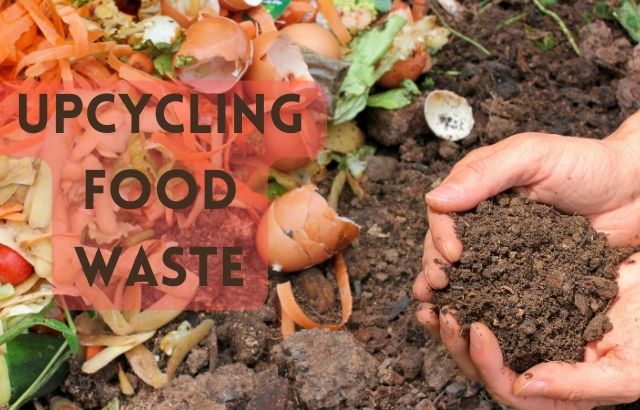In a world increasingly conscious of its environmental footprint, the concept of upcycling has gained significant traction. Upcycling involves taking items or materials that would otherwise be discarded and transforming them into something of greater value or quality. When it comes to food waste, upcycling is not only innovative but also crucial for reducing our ecological impact. Let’s delve into the fascinating realm of upcycling food waste and explore some inspiring examples.
Upcycling Food Waste- inspiring examples.
1. Turning Scraps into Meals:
One of the simplest yet effective forms of upcycling food waste is using vegetable scraps to create flavorful stocks and broths. Items like carrot peels, onion skins, and herb stems are often discarded but contain valuable nutrients and flavors. By simmering these scraps with water and seasoning, you can create a base for soups, stews, and sauces that not only reduces waste but also enhances the depth of your culinary creations.
2. Transforming Stale Bread:
Stale bread is a common kitchen waste item, but it can be revitalized into delicious dishes. Bread crumbs are a versatile ingredient used in coatings for fried foods or as a topping for baked dishes like macaroni and cheese. Additionally, stale bread can be transformed into croutons or used as a base for bread pudding or strata, making it a valuable resource rather than trash.
3. Repurposing Fruit Peels:
Citrus peels, such as those from oranges, lemons, and limes, can be transformed into zesty additions for cooking and baking. Citrus zest adds bright flavors to salads, marinades, and desserts. Furthermore, citrus peels can be candied to create a sweet treat or infused into vinegar for a tangy homemade cleaner.
4. Creating Garden Fertilizer:
Food scraps that are not suitable for human consumption, such as coffee grounds, eggshells, and vegetable trimmings, can be composted to create nutrient-rich fertilizer for gardens. Composting not only reduces landfill waste but also enriches soil, promoting healthier plants and closing the loop in the food production cycle.
5. Brewing Beer from Bread:
Innovative breweries are tackling food waste by brewing beer using surplus bread. Bread is substituted for a portion of the malted barley typically used in beer production, resulting in unique flavors and reducing the environmental impact associated with food waste. This initiative not only raises awareness but also demonstrates the potential for creativity in sustainable practices.
6. Upcycled Snacks:
Companies are now upcycling food waste into tasty snacks. For instance, surplus fruits and vegetables deemed unsuitable for retail due to imperfections are transformed into nutritious snacks like fruit leather or vegetable crisps. This approach not only reduces waste but also provides consumers with healthy alternatives to traditional snacks.
7. Coffee Grounds as Skincare:
Coffee grounds, often discarded after brewing, can be repurposed as a natural exfoliant in skincare products. The coarse texture of coffee grounds helps to slough away dead skin cells, leaving skin smoother and brighter. Additionally, coffee grounds can be used in homemade scrubs and masks, offering a sustainable and eco-friendly alternative to synthetic exfoliants.
Ask jaiguru about Upcycling Food Waste

What is recycling food waste?
Answer: Upcycling food waste involves transforming discarded food materials into new products of higher value or quality. This process aims to reduce waste and environmental impact by creatively repurposing food that would otherwise be thrown away.
How does recycling food waste contribute to sustainability?
Answer: Upcycling food waste helps reduce the amount of organic matter sent to landfills, which in turn decreases methane emissions—a potent greenhouse gas. By utilizing food waste to create new products or ingredients, it conserves resources and promotes a circular economy.
What are some examples of up-cycled food products?
Answer: Examples include turning fruit and vegetable scraps into juices or snacks, using spent grains from brewing beer to make bread or animal feed, and extracting oils from used coffee grounds for cosmetics or biofuels.
How can businesses benefit from recycling food waste?
Answer: Businesses can benefit financially by reducing waste disposal costs and creating new revenue streams from upcycled products. Moreover, it enhances brand reputation as a socially and environmentally responsible company.
What are the challenges of recycling food waste?
Answer: Challenges include sourcing consistent and clean waste materials, complying with food safety regulations, and overcoming consumer perception about products made from food waste. However, innovative approaches and education can address these challenges effectively.
Is recycling food waste economically viable?
Answer: Yes, upcycling food waste can be economically viable when done strategically. By identifying valuable uses for waste materials and reducing disposal costs, businesses can achieve cost savings and create sustainable revenue models.
How can individuals contribute to upcycling food waste?
Answer: Individuals can contribute by composting at home, supporting businesses that use upcycled products, and advocating for policies that promote food waste reduction and recycling. Small actions collectively make a significant impact on reducing food waste.
upcycling food waste – Final Words

Upcycling food waste not only minimizes environmental impact but also encourages creativity and innovation in culinary and manufacturing practices. Whether it’s transforming kitchen scraps into flavorful meals, brewing beer from surplus bread, or creating skincare products from coffee grounds, the possibilities for upcycling food waste are vast and inspiring. By embracing these practices, individuals and businesses can contribute to a more sustainable future while discovering the hidden treasures within what was once considered trash. Join the movement today and unlock the potential of upcycling food waste in your own life!












